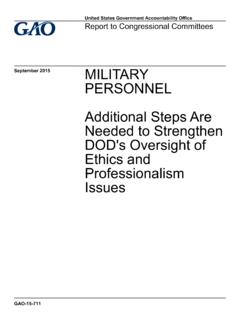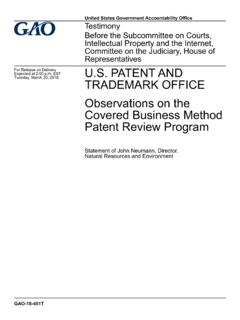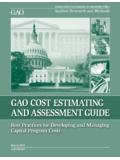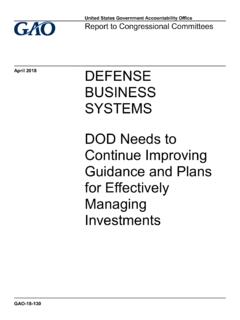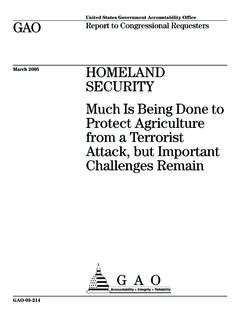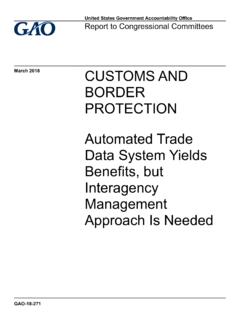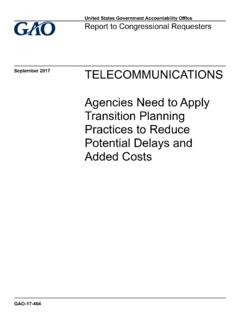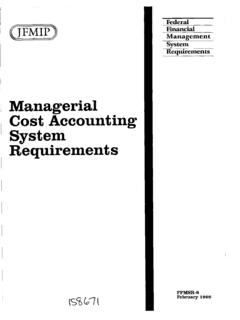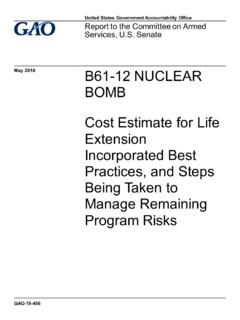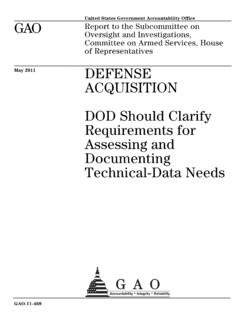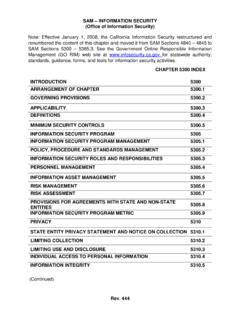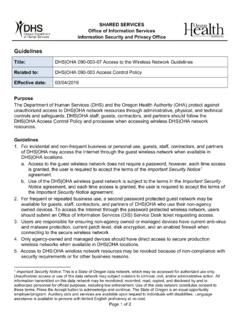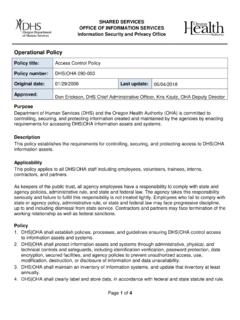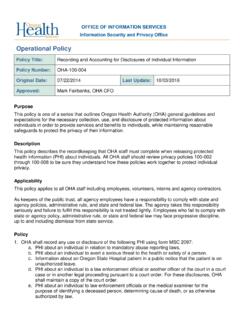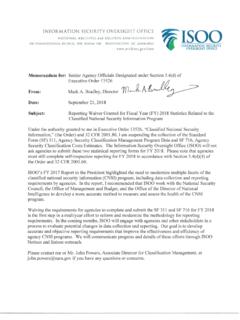Transcription of GAO-16-501, Information Security: Agencies Need to Improve ...
1 Information security Agencies Need to Improve Controls over Selected High-Impact Systems Report to Congressional Requesters May 2016 GAO-16-501 United States government accountability office United States government accountability office Highlights of GAO-16-501, a report to congressional requesters May 2016 Information security Agencies Need to Improve Controls over Selected High-Impact Systems Why GAO Did This Study Federal systems categorized as high impact those that hold sensitive Information , the loss of which could cause individuals, the government , or the nation catastrophic harm warrant increased security to protect them. In this report, GAO (1) describes the extent to which Agencies have identified cyber threats and have reported incidents involving high-impact systems, (2) identifies government -wide guidance and efforts to protect these systems, and (3) assesses the effectiveness of controls to protect selected high-impact systems at federal Agencies .
2 To do this, GAO surveyed 24 federal Agencies ; examined federal policies, standards, guidelines and reports; and interviewed agency officials. In addition, GAO tested and evaluated the security controls over eight high-impact systems at four Agencies . What GAO Recommends GAO recommends that OMB complete its plans and practices for securing federal systems and that NASA, NRC, OPM, and VA fully implement key elements of their Information security programs. The Agencies generally concurred with GAO s recommendations, with the exception of OPM. OPM did not concur with the recommendation regarding evaluating security control assessments. GAO continues to believe the recommendation is warranted. In separate reports with limited distribution, GAO is making specific recommendations to each of the four Agencies to mitigate identified weaknesses in access controls, patch management, and contingency planning. What GAO Found In GAO s survey of 24 federal Agencies , the 18 Agencies having high-impact systems identified cyber attacks from nations as the most serious and most frequently-occurring threat to the security of their systems.
3 These Agencies also noted that attacks delivered through e-mail were the most serious and frequent. During fiscal year 2014, 11 of the 18 Agencies reported 2,267 incidents affecting their high-impact systems, with almost 500 of the incidents involving the installation of malicious code. government entities have provided guidance and established initiatives and services to aid Agencies in protecting their systems, including those categorized as high impact. The National Institute of Standards and Technology has prescribed federal standards for minimum security requirements and guidance on security and privacy controls for high-impact systems, including 83 controls specific to such systems. The office of Management and Budget (OMB) is developing plans for shared services and practices for federal security operations centers but has not issued them yet. In addition, Agencies reported that they are in the process of implementing various federal initiatives, such as tools to diagnose and mitigate intrusions on a continuous basis and stronger controls over access to agency networks.
4 The National Aeronautics and Space Administration (NASA), Nuclear Regulatory Commission (NRC), office of Personnel Management (OPM), and Department of Veterans Affairs (VA) had implemented numerous controls over the eight high-impact systems GAO reviewed. For example, all the Agencies reviewed had developed a risk assessment for their selected high-risk systems. However, the four Agencies had not always effectively implemented access controls. These control weaknesses included those protecting system boundaries, identifying and authenticating users, authorizing access needed to perform job duties, and auditing and monitoring system activities. Weaknesses also existed in patching known software vulnerabilities and planning for contingencies. An underlying reason for these weaknesses is that the Agencies had not fully implemented key elements of their Information security programs, as shown in the table. Agency Implementation of Key Information security Program Elements for Selected Systems NASA NRC OPM VA Risk assessments security plans Controls assessments Remedial action plans Source: GAO analysis of agency documentation.
5 | GAO-16-501 Note: Met Partially met Did not meet Until the selected Agencies address weaknesses in access and other controls, including fully implementing elements of their Information security programs, the sensitive data maintained on selected systems will be at increased risk of unauthorized access, modification, and disclosure, and the systems at risk of disruption. View GAO-16-501. For more Information , contact Gregory C. Wilshusen at (202) 512-6244 or or Nabajyoti Barkakati at (202) 512-4499 or Page i GAO-16-501 Federal High-Impact System security Letter 1 Background 3 Agencies Have Identified a Variety of Cyber Threats and Incidents, Some More Serious and Prevalent than Others 9 Various government Entities Provide Guidance and Efforts Intended to Help Protect Systems 25 Selected Agencies We Reviewed Did Not Always Implement Controls for Selected Systems Effectively 44 Conclusions 58 Recommendations 59 Agency Comments and Our Evaluation 61 Appendix I Objectives, Scope, and Methodology 66 Appendix II Comments from the National Aeronautics and Space Administration 72 Appendix III Comments from the Nuclear Regulatory Commission 75 Appendix IV Comments from the office of Personnel Management 78 Appendix V Comments from the Veterans Administration 82 Appendix VI Comments from the Department of Homeland security 85 Appendix VII GAO Contacts and Staff Acknowledgments 87 Tables Table 1.
6 Adversarial Cyber Threat Sources 10 Contents Page ii GAO-16-501 Federal High-Impact System security Table 2: Common Cyber Threat Attack Methods and Exploits 12 Table 3: Cyber Threat Attack Vectors 15 Table 4: Non-adversarial Types of Cyber Threat Sources 17 Table 5: US-CERT Incident Categories 23 Table 6: July 2015 Cybersecurity Sprint Results for Personal Identity Verification Implementation for 18 Agencies that Had High-Impact Systems 37 Table 7: Services Available for Federal Agencies to Protect Their High-Impact Information Systems 40 Table 8: Access Control Weaknesses Identified for Eight Selected Systems 45 Table 9: Agency Compliance with Contingency Plan Elements 48 Table 10: Specific High-Impact Controls Addressed in Selected Systems security Plans 52 Table 11: Number of Individuals Who Completed Specialized security Training for Fiscal Year 2015 54 Table 12: security Control Assessments for Selected Systems 55 Table 13: Required Components for a Remedial Plan of Action and Milestones 57 Figures Figure 1: Incidents Reported by Federal Agencies , Fiscal Years 2006 through 2015 4 Figure 2: Categorization of Impact Level for Federal Systems in Fiscal Year 2015 8 Figure 3: Most Serious and Most Frequently Identified Adversarial Cyber Threat Sources/Agents, as Reported by 18 Agencies with High-Impact Systems 11 Figure 4: Most Serious and Most Frequently Identified Cyber Attack Methods, as Reported by 18 Agencies with High-Impact Systems 14 Figure 5: Most Serious and Most Frequently Identified Cyber Threat Vectors, as Reported by 18 Agencies with High-Impact Systems 16 Figure 6: Most Serious and Most Frequently Used Non-adversarial Cyber Threat Sources, as Reported by 18 Agencies with High-Impact Systems 18 Figure 7.
7 Usefulness of Federal Resources in Assisting Agencies in Identifying Cyber Threats, as Reported by 18 Agencies with High-Impact Systems 20 Page iii GAO-16-501 Federal High-Impact System security Figure 8: Challenges Hindering Agencies in Identifying Cyber Threats, as Reported by 18 Agencies with High-Impact Systems 22 Figure 9: Incidents Affecting High-Impact Systems During Fiscal Year 2014, as Reported by 11 Agencies 24 Figure 10: Usefulness of Guidance to Agencies in Protection of High-Impact Systems, as Reported by 18 Agencies 29 Figure 11: Agency Implementation of government -wide Initiatives Related to the Continuous Diagnostics and Mitigation Programs, as Reported by 17a Agencies with High-Impact Systems 35 Figure 12: Extent to Which Agencies Participated in and Found the Services to Protect Their High-Impact Systems Useful, as Reported by 18 Agencies 42 Page iv GAO-16-501 Federal High-Impact System security Abbreviations Agriculture Department of Agriculture C-CAR Federal Cybersecurity Coordination, Assessment.
8 And Response CDM Continuous Diagnostics and Mitigation Commerce Department of Commerce Defense Department of Defense DHS Department of Homeland security Education Department of Education Energy Department of Energy EPA Environmental Protection Agency FIPS Pub Federal Information Processing Standard Publication FISMA Federal Information security Modernization Act of 2014 HHS Department of Health and Human Services HUD Department of Housing and Urban Development Interior Department of the Interior ISIMC Information security and Identity Management Committee Justice Department of Justice Labor Department of Labor NASA National Aeronautics and Space Administration NCPS National Cybersecurity Protection System NIST National Institute of Standards and Technology NRC Nuclear Regulatory Commission NSF National Science Foundation OMB office of Management and Budget OPM office of Personnel Management PIV personal identity verification POA&M plan of action and milestones SBA Small Business Administration SSA Social security Administration State Department of State TIC Trusted Internet Connections Transportation Department of Transportation Treasury Department of the Treasury USAID Agency for International Development US-CERT United States Computer Emergency Readiness Team VA Department of Veterans Affairs This is a work of the government and is not subject to copyright protection in the United States.
9 The published product may be reproduced and distributed in its entirety without further permission from GAO. However, because this work may contain copyrighted images or other material, permission from the copyright holder may be necessary if you wish to reproduce this material separately. Page 1 GAO-16-501 Federal High-Impact System security 441 G St. Washington, DC 20548 May 18, 2016 The Honorable Ron Johnson Chairman The Honorable Thomas R. Carper Ranking Member Committee on Homeland security and Governmental Affairs United States Senate The Honorable Susan M. Collins United States Senate The breach at the office of Personnel Management (OPM), reported in July 2015, affected at least million individuals and demonstrates the catastrophic effect that such an incident can have on an agency s mission and national security . Increasingly sophisticated threats to Information technology systems and the damage that can be generated underscore the importance of managing and protecting them.
10 This is particularly true for those systems Agencies categorize as high impact, where the loss of confidentiality, integrity, or availability can have a severe or catastrophic adverse effect on organizational operations, assets, or individuals. Such an impact can result in loss or degradation of mission capability, severe harm to individuals, or major financial loss. Having government -wide guidance, initiatives, and services in place is important for their protection. Since 1997, we have designated federal Information security as a government -wide high-risk area, and in 2003 expanded this area to include computerized systems supporting the nation s critical Most recently, in the February 2015 update to our high-risk list, we further expanded this area to include protecting the privacy of personally identifiable 1 See GAO, High-Risk Series: An Update, GAO-15-290 (Washington, : Feb.)
